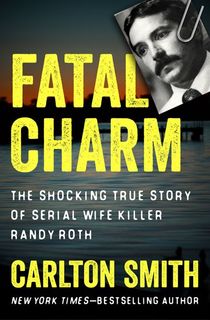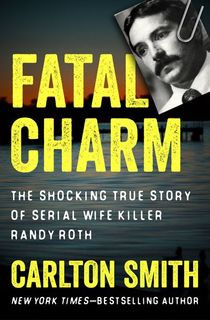On July 23, 1991, Randy Roth and his family set out for a fun day at Lake Sammamish in Washington. But before the day's end, their lives would be changed forever.
While out on the lake, Randy claimed that an inflatable raft had fallen on his wife Cindy—causing her to drown. But Randy’s calm and matter-of-fact behavior told a different story. And when his neighbor Stacey Reese reported Randy’s suspicious demeanor to detective Sue Peters…the floodgates of his past opened. Not only was his current predicament suspicious, but this wasn’t the first wife of Randy’s to die “accidentally.” Married four times, his second wife, Janis Roth, fell 300 feet to her death in 1981 while hiking at Beacon Rock in Washington. With no witnesses, there was no way to prove Randy was at fault.
In both cases, Randy immediately cremated his wife’s remains and attempted to cash in on very large life insurance policies he had taken out on them—heightening suspicions. In Carlton Smith’s true crime book, Fatal Charm, readers are given a first-hand look at the shocking evil of a man who almost got away with murder…twice.
Read on for an excerpt from Fatal Charm, and then download the book.
About the time the memorial service for Cindy Roth was drawing to a close, Stacey Reese was calling the police.
Stacey explained to the police operator that she might know something about the woman who had drowned. The operator connected her with Sue Peters in major crimes.
Sue Peters always answered her telephone the same way. “Detective Peters,” she said.
Stacey told Peters that she didn’t know whether it was important or not, but that she knew the man whose wife had drowned. “Oh?” Peters asked.
Yes, said Stacey. His name is Randy Roth, and he works where I work. “How well do you know him?” Peters asked.
“I’ve gone to lunch with him a couple of times,” Stacey said. Beginning when? Peters asked. Beginning earlier in the year, shortly after she had started work at the car dealership, Stacey said. In fact, Stacey said, she and Randy had lunch together in a park only the day before Randy’s wife had drowned.
“Really?” said Peters, to encourage her to go on.
Yes, said Stacey. Randy wasn’t very happy with Cindy, Stacey told Peters. In fact, Randy told her he and Cindy weren’t really married, that they only had a one-year “marriage contract.” Randy told her the contract “was just about up.” Randy complained about Cindy a lot, Stacey said.
“He said she was obsessive and nasty,” Stacey continued. “He said she was too bitchy.” Randy made it clear to her that he wanted to get out of the relationship. In fact, Stacey said, she had the impression that either Cindy or Randy, one or the other, was packing to move out when the drowning happened.
Still, moving out was one thing, and dying was another.
Tell me about Randy, Peters encouraged.
Well, Stacey offered, Randy was a Vietnam veteran. He talked a lot about Vietnam, and he talked about death a lot, too. “He said that in the last six weeks, four of his family members had died,” Stacey told Peters. He’d said this just the day before the drowning.
Stacey faltered a bit, and Peters realized that she was frightened. It wasn’t so much that Stacey was frightened of Randy, Peters sensed, as much as of the act of actually calling the police to report these suspicions. Peters could imagine Stacey’s predicament: one day Randy tells her he doesn’t like his wife, that he wants to end the relationship, that he was in Vietnam, that four of his family members have died in six weeks, and the very next day the unwanted wife is dead. It would make anybody wonder.
But what if the drowning was just a horrible coincidence? By calling the police to report the information, Stacey could be getting Randy in a lot of trouble. After all, he seemed a nice enough guy. And what if it got out at work that Stacey had said anything to the police? That would make her look like a troublemaker, like she was some sort of stool pigeon.
Peters assured Stacey that no one would know Stacey had called unless Randy were charged with a crime, and that was a long way off, if ever. Stacey said she understood that, but it still made her nervous. Stacey told Peters about a call she’d had from Randy two days after Cindy drowned.
“I asked him, ‘Are you all right?’ and he said, ‘Why wouldn’t I be?’” Stacey told Peters.

Randy’s attitude was the thing, Stacey said. He was acting like Cindy’s death was no big deal. Later the same night, Stacey told Peters, Randy had called her a second time, and this time he talked about the drowning. “He said it was a horrible thing,” Stacey recounted. But then Randy suggested that perhaps Cindy had subconsciously wanted to die because their relationship was over. It gave Stacey the creeps.
But that wasn’t all. Randy complained about the way Cindy had decorated their new house. “He said, ‘It’s going to take me fucking forever to get this pink and mauve out of here.’”
Randy called her a third time to ask her out to breakfast a few days later, Stacey continued. She turned him down, Stacey told Peters. It just felt all wrong, Stacey said. She had the feeling—it was only a feeling—that maybe, just maybe, Randy had killed his wife so he’d be free to make a play for her.
Then Stacey, growing more nervous, told Peters something that focused the detective’s mind wonderfully: “You know that Randy was married before?” Stacey asked. “He told me the day before the drowning, while we were having lunch in the park, that his second wife died in a hiking accident. She fell off a cliff about ten years ago. They’d only been married about eight months when it happened.’
Peters’ mind churned as she took in this development. So Randy Roth had been married before, and that wife had died too—also outdoors, also accidentally, it seemed. Very convenient, Peters thought. But who was the first wife? Where had the accident happened?
Peters pressed Stacey for more details, but Stacey had reached her limit. “I can’t talk any more. I’m at work,” she said, and hung up.
There had to be some way to find out who the first wife was, Peters thought. Too bad she hadn’t known about the earlier wife when talking to Randy that morning; she could have asked him. That reminded Peters of the tape-recorded statement she’d taken from Randy about the circumstances of Cindy’s drowning. She decided to take a copy of the tape over to the medical examiner’s office to let people there listen to it. Maybe the medical experts would hear Randy’s taped version of the drowning—at least listen to his voice—and decide there was just no way it could have happened that way. Maybe, after listening to Randy’s own words, they would reconsider their tentative decision to classify the death as an accident.
Peters drove over to the county medical examiner’s offices and met with Dr. Reay. Reay listened to the tape, and afterward Peters had questions. Based on Randy’s story, did Reay now think Randy could have drowned Cindy deliberately? Was it possible for a person to drown so quickly? Was there anything at all to indicate murder rather than accident? For example, were there any marks on Cindy that might have indicated she’d been held under until she drowned?
Reay said he couldn’t be sure, but he didn’t think so. Yes, there were the two small scratches on Cindy’s neck, but they could have come from the resuscitation violence. The tape didn’t clarify the matter very much, Reay said. Based on the available medical evidence, he said, he’d have to stick with the idea that the death was a probable accident.
Peters was only slightly disappointed. She was still thinking about Stacey Reese’s phone call. Peters was growing more and more convinced that Randy Roth had murdered Cindy Roth, no matter what the medical evidence suggested, or rather, failed to suggest. But why? Why would Randy have murdered Cindy?
Tomorrow, Peters decided, she would start trying to find out who Randy Roth’s first dead wife was. Maybe that would shed more light on the death of the second.

[…]
The first thing to do, Peters realized, was track down the earlier investigation into the death of the second wife, the one named Jan. There might be details there that could shed light on Randy’s more recent activities, maybe even the name of an insurance broker. That might help her learn whether Cindy Roth had also been insured.
Mary Jo’s story about the death of the first wife—actually, the second wife, Peters reminded herself—dovetailed somewhat with the information from Stacey Reese and Roseanne. Mary Jo, of course, had more details: Mt. Rainier, climbing, ropes. That would be a start. Once she got that pinned down, she could look for someone who might know about life insurance on Cindy; maybe Lori Baker would know about that.
Mt. Rainier, the 14,410-foot dormant volcano that dominates the skyline southeast of Seattle, is one of the premier climbing meccas in the country. It was perfectly plausible that Jan Roth—Peters assumed Jan used Randy’s last name—had fallen while climbing there. Each year, it seemed, several people were killed on the mountain. The peak was in Pierce County, the county immediately to the south of Seattle. Peters called the Pierce County Medical Examiner’s Office to see whether they had any record of a Jan Roth having been killed on Mt. Rainier. The Pierce County officials told her they had no Jan Roth in their records.
Rats! thought Peters. Five minutes later, she called the state’s bureau of vital statistics. An official there found a record for the death of a Janis L. Roth, who had died November 27, 1981 at a place called Beacon Rock State Park in Skamania County. Peters knew Skamania County was in the mountainous south-central portion of Washington State, along the Columbia River, about an hour east of Portland, Oregon.
The death certificate for Janis Roth said she had been twenty-nine years old when she died in a three-hundred-foot fall from Beacon Rock, a near vertical, ancient volcanic plug that rose some eight hundred feet above the Columbia River valley. The rock was at the center of a state park. Another park, Peters noted. The records identified the dead woman’s husband as Randolph G. Roth of Mountlake Terrace. The death was classified as an accident. Was it the same Randy Roth?
Peters dialed the number for the Skamania County Sheriff’s Office and was connected with Undersheriff Mike Grossie. Peters explained that she was investigating the recent death of a woman named Cynthia Roth, who had been married to a man named Randy Roth. Peters said she’d heard of a Randy Roth who had been married to a woman who had died in a fall in Grossie’s jurisdiction. Her question was: was this the same man as her Randy Roth?
Grossie remembered his Randy Roth very well. He found the file on the fatal fall. His Randy Roth had the same birthdate as Peters’ Randy and the same driver’s license number. It had to be the same person, Grossie agreed. Grossie, who supervised and often conducted most of the criminal investigations for the largely rural county, went on to tell Peters why he was quite familiar with his Randy Roth.
Ten years earlier, Grossie told Peters, he was convinced that his Randy had murdered Janis Roth by shoving her off Beacon Rock to collect $100,000 in insurance on her life. He just hadn’t been able to prove it.


